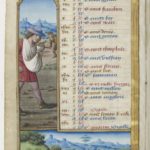
“October”, kalendar page from Les Petites Heures d’Anne de Bretagne (The Little Hours of Queen Anne of Bretagne), by the Maître des Triomphes de Pétrarque. From Bibliothèque nationale de France, Paris (France).
In his letters, Ignatius stressed the value of the Eucharist. He was also the first Christian writer to promote the observance of Sunday as the Lord’s Day, in preference to Saturday, the Jewish Sabbath. He also advocated a strong ecclesiastical hierarchy, with each city of diocese governed by a bishop who is assisted by presbyters (priests) and deacons. Ignatius is also the first to describe the Church as katholikos (καθολικός), meaning “universal”, “complete”, or “whole”. (This is why, as Anglicans, we believe “one Holy, Catholick, and Apostolick Church”—pace the Roman Catholics, who want to claim the adjective for themselves.)
It’s not exactly clear why Ignatius was taken to Rome to be martyred. And it’s less clear why his Roman escort took the land route across Asia Minor, where Ignatius was allowed to preach to local Christian communities. Antioch, Ignatius’s home city, was a major seaport, and the sea route would have been quicker and cheaper. Ignatius’s letters, however, clearly document his land travels and his prediction that he would be thrown to the beasts. In the fourth century, Eusebius reported that Ignatius was indeed thrown to the beasts—specifically lions, according to Jerome, and in the Coliseum, according John Chrysostom.
Ignatius’s feast day is 17 October.


